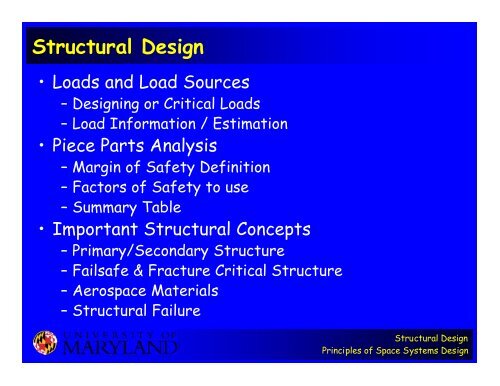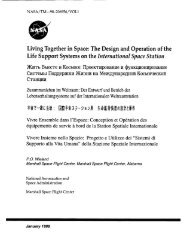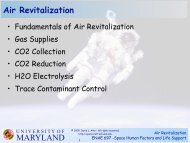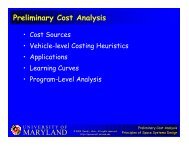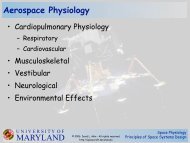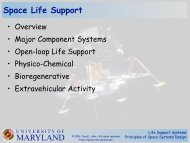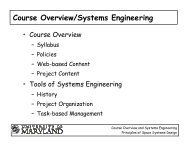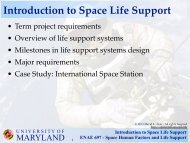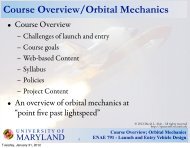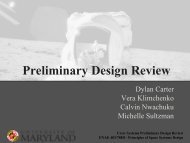Structural Design
Structural Design
Structural Design
Create successful ePaper yourself
Turn your PDF publications into a flip-book with our unique Google optimized e-Paper software.
<strong>Structural</strong> <strong>Design</strong><br />
¥ Loads and Load Sources<br />
Ð <strong>Design</strong>ing or Critical Loads<br />
Ð Load Information / Estimation<br />
¥ Piece Parts Analysis<br />
Ð Margin of Safety Definition<br />
Ð Factors of Safety to use<br />
Ð Summary Table<br />
¥ Important <strong>Structural</strong> Concepts<br />
Ð Primary/Secondary Structure<br />
Ð Failsafe & Fracture Critical Structure<br />
Ð Aerospace Materials<br />
Ð <strong>Structural</strong> Failure<br />
<strong>Structural</strong> <strong>Design</strong><br />
Principles of Space Systems <strong>Design</strong>
Loads<br />
¥ "<strong>Design</strong>ing Load" is the load that determines one or<br />
more structural characteristic of the part:<br />
Ð shape, thickness, strength, stiffness, material...<br />
¥ Critical Load (somewhat synonymous) is more exactly<br />
the load that gives the minimum margin of safety (MS)<br />
for a part<br />
Ð MS represents the amount of extra structural capability you<br />
have over the applied load (elbow room)<br />
¥ Examples of Critical Loads<br />
Ð pressurization loads for a rocket casing<br />
Ð launch loads for a spacecraft<br />
Ð thermal loads for a propulsion subsystem<br />
Ð crash loads for a car<br />
<strong>Structural</strong> <strong>Design</strong><br />
Principles of Space Systems <strong>Design</strong>
Load Sources<br />
¥ Where do these loads come from?<br />
¥ For every part (subsystem) in your design, you should<br />
review every phase of its life and identify all loads that<br />
have the potential to be critical:<br />
Ð manufacturing & assembly<br />
Ð test (qualification, proof test)<br />
Ð transportation (truck or launch)<br />
Ð operation<br />
Ð contingencies (crash landing)<br />
¥ Obtain or estimate loads<br />
Ð look up loads in reference books<br />
Ð ask other groups to determine loads<br />
Ð guestimate for the purposes of starting analysis<br />
¥ Calculate all margins of safety<br />
<strong>Structural</strong> <strong>Design</strong><br />
Principles of Space Systems <strong>Design</strong>
Launch Vehicle Loads<br />
¥ Max Q - Aerodynamic Loads<br />
ÐQ = r V 2 / 2<br />
Ð maximum pressure and bending on vehicle<br />
¥ Max g's<br />
Ð usually occurs at stage burnout<br />
Ð maximum axial load on vehicle and payload<br />
¥ Abrupt environmental & vehicle changes<br />
Ð internal and external pressure drop<br />
Ð dramatic thermal changes<br />
¥ Staging shock loads<br />
Ð high g's, high frequency<br />
¥ Random vibration and acoustics<br />
Ð equiv. g's = sqrt (p PSD f n Q / 2)<br />
¥ Some of these loads apply to payload as well<br />
<strong>Structural</strong> <strong>Design</strong><br />
Principles of Space Systems <strong>Design</strong>
Launch Vehicle Failures<br />
¥ LV failures are tied to the following<br />
subsystems<br />
Ð Propulsion (70%)<br />
Ð Avionics (11%)<br />
Ð Separation (8%)<br />
Ð Electrical (7%)<br />
Ð <strong>Structural</strong> (2%)<br />
¥ <strong>Structural</strong> Failure Relatively Rare<br />
Ð AmRoc, Shuttle, Pegasus<br />
¥ Propulsion or Control System Failure More<br />
Common<br />
Ð Conestoga, LLV, Ariane V<br />
<strong>Structural</strong> <strong>Design</strong><br />
Principles of Space Systems <strong>Design</strong>
Spacecraft On-Orbit Loads<br />
¥ Accelerations<br />
Ð orbital accelerations<br />
Ð gravity gradient<br />
Ð spinning<br />
Ð on-board disturbances<br />
Ð thrusting (attitude control, reboost)<br />
¥ Thermal Loads<br />
Ð sun / shadow thermal gradients<br />
Ð eclipse effects (thermal snap)<br />
¥ Other Special Cases<br />
Ð EVA loads (corners & edges)<br />
Ð rendezvous & docking<br />
¥ Generally spacecraft are designed by launch loads!<br />
<strong>Structural</strong> <strong>Design</strong><br />
Principles of Space Systems <strong>Design</strong>
Planetary Vehicle Loads<br />
¥ Vibration loads from traversing rough<br />
terrain<br />
¥ Launch / landing loads<br />
¥ Maneuvering loads<br />
Ð tight turn<br />
Ð driving on an incline<br />
Ð loosing traction / support on one wheel<br />
¥ Crash loads<br />
Ð driving into a big boulder<br />
Ð rolling vehicle in unstable soil<br />
Ð safety is primary consideration<br />
<strong>Structural</strong> <strong>Design</strong><br />
Principles of Space Systems <strong>Design</strong>
Piece Parts Analysis<br />
¥ <strong>Structural</strong> analysis of a system consists of at least<br />
the following three tasks<br />
Ð Load Cycle Modeling (system-level) - iterative process<br />
Ð Piece-Part Analysis (static) - minimum margins of safety<br />
Ð Fracture and Fatigue Analysis (dynamic) - safe life<br />
analysis<br />
¥ Piece Parts Analysis<br />
Ð Identify all loads on each part / subsystem<br />
Ð Calculate margins of safety<br />
Ð Tabulate minimum margins of safety<br />
¥ Example: OTD Boom Piece Parts Analysis<br />
<strong>Structural</strong> <strong>Design</strong><br />
Principles of Space Systems <strong>Design</strong>
Factors & Margins of Safety<br />
¥ Limit Loads: maximum loads expected (applied loads)<br />
¥ Yield Load and Ultimate Load<br />
¥ Factors of Safety : numbers imposed by the Customer<br />
(or your own good sense) that reflect<br />
how uncertain you are of the load or structure<br />
how safe you want to be<br />
examples: 10 for bridges, 5 for ground handling equip, 2 for a/c<br />
¥ Margins of Safety are calculated as follows:<br />
MS<br />
Allowable Load<br />
= - 10 .<br />
Applied Load x FS<br />
¥ Beware: There are other definitions of these terms in engineering, but the<br />
above approach is the most common in Aerospace<br />
<strong>Structural</strong> <strong>Design</strong><br />
Principles of Space Systems <strong>Design</strong>
Primary Structure<br />
¥ Primary, Secondary, & Tertiary Structure<br />
Ð Primary structure is the system's backbone (carries all of<br />
the major loads imposed on vehicle)<br />
Ð Secondary structure includes all essential appendages and<br />
support structures (such as solar arrays, antennas, & fuel<br />
tanks)<br />
Ð Tertiary structures are less-essential mounting hardware<br />
(brackets, component housings, connector panels)<br />
¥ Example of primary structure<br />
Ð Thin-walled cylindrical launch vehicle<br />
Ð Challenge is to figure out how to react shear & torsion<br />
stresses<br />
Ð Buckling of skin is most common failure mode<br />
Ð Buckling of a cylindrical section:<br />
s crit = E t / R sqrt [3(1-n 2 )]<br />
<strong>Structural</strong> <strong>Design</strong><br />
Principles of Space Systems <strong>Design</strong>
Critical Structure<br />
¥ Critical Items List (CIL) contains all parts that<br />
Ð are deemed criticality 1 by FMEA (ie, single point failures)<br />
Ð are fracture critical (ie, stressed to the point where a flaw will grow to<br />
critical size)<br />
¥ Failsafe & Fracture Critical Structure<br />
Ð Catastrophic failure is generally defined by customer<br />
Ð Failsafe structure can take redistributed loads after failure (ie, not<br />
single point failures); shall release no hazardous mass; shall not change<br />
dynamics significantly; shall have no fatigue problems<br />
Ð Low-risk structure is not primary structure; has only a remote<br />
possibility of failure; will not propagate a crack in 4 lifetimes<br />
s max < F tu / [ 4 (1-0.5 R) K t ]<br />
Ð Fracture critical parts must be labeled and analyzed as such, then<br />
inspected, treated, and tracked more carefully than conventional parts<br />
¥ Crack Growth Analysis (FLAGRO)<br />
Ð All FC parts must be shown good for four lifetimes of load cycles with an<br />
initial flaw (determined by NDI)<br />
<strong>Structural</strong> <strong>Design</strong><br />
Principles of Space Systems <strong>Design</strong>
Aerospace Materials<br />
¥ Comparison of specific stiffness, specific<br />
strength, and buckling parameter for a<br />
variety of aerospace metals and<br />
composites<br />
¥ Definition of <strong>Structural</strong> Failure<br />
Ð Detrimental Yield vs Textbook Yield<br />
¥ deformation that detrimentally affects<br />
functionality of system<br />
¥ 0.2% Tresca yield condition (assumes system linear<br />
in first place)<br />
Ð Ultimate Failure<br />
¥ any material rupture or loss of functionality<br />
<strong>Structural</strong> <strong>Design</strong><br />
Principles of Space Systems <strong>Design</strong>
Material Strength & Stiffness<br />
¥ Typical Yield & Ultimate Strengths<br />
Ð aluminum yld: 37 ksi ult: 42 ksi<br />
Ð low strength steel yld: 36 ksi ult: 58 ksi<br />
Ð high strength steel yld:102 ksi ult:116 ksi<br />
Ð titanium yld:134 ksi ult:145 ksi<br />
¥ Stiffness versus Strength <strong>Design</strong>s<br />
Ð aluminum w: 0.10 E/w: 100 s u /w: 420<br />
Ð Low s u steel w: 0.28 E/w: 102 s u /w: 204<br />
Ð high s u steel w: 0.29 E/w: 98 s u /w: 390<br />
Ð titanium w: 0.16 E/w: 109 s u /w: 906<br />
Conclusion: for aerospace structures - titanium<br />
and aluminum<br />
<strong>Structural</strong> <strong>Design</strong><br />
Principles of Space Systems <strong>Design</strong>
<strong>Structural</strong> Analysis<br />
¥ Some key structural formulas that are<br />
handy to have for early (back-of-theenvelope)<br />
design analyses:<br />
Ð Spring & Beam Stiffnesses<br />
Ð Beam Natural Frequencies<br />
Ð Euler Buckling Loads<br />
Ð Stresses in Simple Pressurized Shell<br />
s hoop = p R / t ; s long = p R / 2 t<br />
Ð Random Vibe and Acoustic Equivalent g's<br />
<strong>Structural</strong> <strong>Design</strong><br />
Principles of Space Systems <strong>Design</strong>


